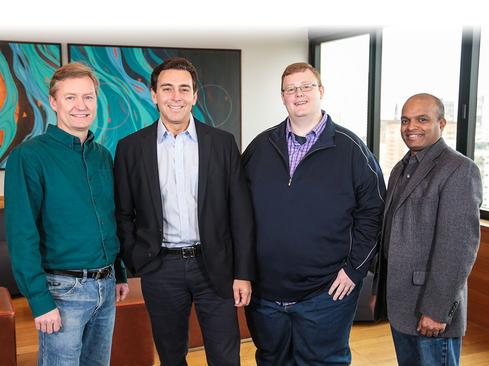Deloitte Consulting report on the future of IT sees 'Unbound IT' aligned with the 'kinetic enterprise' and able to tap external tech resources.

The enterprise must become more flexible and agile as the digital economy pushes out repeated waves of business change. Making IT part of that kinetic enterprise is no small task. Deloitte Consulting, in its eighth annual report on tech trends, outlined the ways an IT organization will have to change to keep up.
In the process, it highlighted a few companies that embody those changes, ones that are "developing the dexterity and vision required not only to overcome operational inertia but to thrive in a business environment that is, and will remain, in flux."
This is no small task, it adds, in an understatement.
The first goal is to diminish the notion that IT consists of a number of discrete functional silos, each distinct from the others, such as development, test, quality assurance, network engineering, application operations or storage management. The goal is "unbounded IT," consisting of multi-skill teams that can talk to and collaborate more easily with the business. It requires the CIO and other top IT managers "to start viewing IT through a different operational and strategic lens," the report, Tech Trends 2017: The Kinetic Enterprise, said.
Such an approach doesn't require throwing out many of IT's past initiatives and starting over. On the contrary, "much of the transformative work CIOs have done during the past decade now serves as the bedrock upon which future initiatives can be grounded," the report states.
Unbounded IT is more about evolving the focus of IT managers and expanding the organization's reach. The ability to continuously learn and grow will enable IT to pursue future opportunities, the authors stated. The section of The Kinetic Enterprise that dealt with the future IT organization itself was written by Atilla Terzloglu, principal of Deloitte's Technology Strategy and Architecture practice; Martin Kamen, Human Capital IT Transformation leader; Tim Boehm, principal with Deloitte Consulting; and Anthony Stephan, US Technology Strategy and Architecture leader.
Want to learn more about the difficulty of achieving rapid updates? See Agile Is King But Continuous Integration Is An Elusive Goal.
Much of IT needs to be restructured into multi-skill teams that are focused, not on one step in the process, say, of software development, but on more holistic results. Exactly what skills would go on a development team versus an operational team the authors didn't say, nor would they endorse the idea that there ought to continue to be a boundary between those two functions. Nevertheless, getting started appeared to be left up to the choice of the individual CIO and IT manager.
"The team, working with product owners, becomes ultimately responsible for an initiative's vision, its design, and day-to-day decision-making. This approach can effectively sidestep the layers of decision rights, council-based sign-offs, and other procedural requirements that routinely kill project momentum," the authors said.
Adopting good DevOps practices and IT autonomic platforms that help keep data center systems running with less human intervention will help It operate faster and more efficiently, they advise.
The next task is taking IT's support and collaboration with the business to a higher level. IT is already striving to be aligned with the business within the limits of what it can currently do. Moving up to the next level requires blurring the traditional line between IT and business teams. It means allowing business managers to pick a software-as-a-service offering, and allowing business analysts to write the rules that will govern its use. IT can selectively decide where it's willing to relax ownership of such outside applications but it must yield some ground and concentrate more on enterprise platforms, reference architectures, data and application use guidance and governance of systems.
"It's the only way to balance the business's desire to move more quickly with technology expertise to mitigate the operational and security threats," the authors wrote.
Another way IT can align with the business at a higher level is to develop new ways to drive innovation. CIOs and IT managers need to build in all the skills they can into their staffs. After that, they must look to business partners, vendors, startups, venture capital firms, and academics to acquire skills that hitherto have been beyond their organization's reach.
"These organizations can be repositories of the kind of fresh ideas, unique perspectives and untapped resources that can inform and inspire IT transformation efforts," the four authors wrote.
As an example, the authors cited Ford Motor Co.'s $182.2 million investment in Pivotal Software in May 2016. Ford has reorganized IT into "core" and "emerging technologies" teams, with the latter bound by fewer rules and able to take more risks.
Separate from the Deloitte report, Ford CEO Mark Fields announced Feb. 10 that the automaker was investing $1 billion in Argo AI to develop an intelligent, machine-learning system for self-driving cars. Argo was founded late last year in Pittsburgh, home of Carnegie Mellon, an AI research center.
The report noted that IT managers can meet momentary or even long term goals without necessarily bringing high-priced skills permanently onto the payroll. "To satisfy evolving skill and talent needs, CIOs may want to participate in external talent ecosystems," said the report's authors.
Whether it is reorganizing internally or tapping into external talent ecosystems, the IT staff must evolve in a direction that allows it to escape the function-oriented silos of the past and perform in a more unbound fashion in cooperation with the business. The kinetic enterprise of the future will demand and IT must adapt to its needs, the authors concluded.
About the Author(s)
You May Also Like







